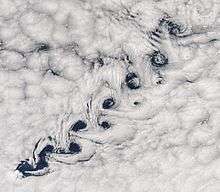Vortex shedding

In fluid dynamics, vortex shedding is an oscillating flow that takes place when a fluid such as air or water flows past a bluff (as opposed to streamlined) body at certain velocities, depending on the size and shape of the body. In this flow, vortices are created at the back of the body and detach periodically from either side of the body. See Von Kármán vortex street. The fluid flow past the object creates alternating low-pressure vortices on the downstream side of the object. The object will tend to move toward the low-pressure zone.
If the bluff structure is not mounted rigidly and the frequency of vortex shedding matches the resonance frequency of the structure, the structure can begin to resonate, vibrating with harmonic oscillations driven by the energy of the flow. This vibration is the cause for overhead power line wires "singing in the wind",[1] and for the fluttering of automobile whip radio antennas at some speeds. Tall chimneys constructed of thin-walled steel tube can be sufficiently flexible that, in air flow with a speed in the critical range, vortex shedding can drive the chimney into violent oscillations that can damage or destroy the chimney. These chimneys can be protected from this phenomenon by installing a series of fences (sometimes called strakes or spoilers) at the top and running down the exterior of the chimney for approximately 20% of its length. The fences are usually located in a helical pattern. The fences prevent strong vortex shedding with low separation frequencies. The optimal pitch for vortex shedding is a 5D pitch (5 x the diameter of the stack).[2]
Vortex shedding was one of the causes proposed for the failure of the original Tacoma Narrows Bridge (Galloping Gertie) in 1940, but was rejected because the frequency of the vortex shedding did not match that of the bridge. The bridge actually failed by aeroelastic flutter.[3]
A thrill ride, "VertiGo" at Cedar Point in Sandusky, Ohio suffered vortex shedding during the winter of 2001, causing one of the three towers to collapse. The ride was closed for the winter at the time.[4] Hasheminejad refinery stacks suffered vortex shedding from 1975 to 2003, seven times irregularly. Some simulation and analyses were done to revealed that the main cause is the interaction of the pilot and stack. The problem solved by removing the pilot. [5]
Governing equation
The frequency at which vortex shedding takes place for an infinite cylinder is related to the Strouhal number by the following equation:
Where is the Strouhal number, is the vortex shedding frequency, is the diameter of the cylinder, and is the flow velocity.
The Strouhal number depends on the body shape and on the Reynolds number.
Mitigation of vortex shedding effects

Modern tall smokestacks usually have a corkscrew fin (a strake) to deliberately introduce turbulence, so that the load is less variable and resonant load frequencies have negligible amplitudes.[6]
A Stockbridge damper is used to mitigate aeolian vibrations caused by vortex shedding on overhead power lines.
See also
- Aeroelastic Flutter - vibration-induced vortices - by way of contrast
- Vortex
- Vortex-induced vibration
- Von Kármán vortex street
References
- ↑ The Mechanical Universe: Mechanics and Heat, Advanced Edition, p. 326
- ↑ "Helical Strakes". Retrieved 2016-07-09.
- ↑ K. Billah and R. Scanlan (1991), Resonance, Tacoma Narrows Bridge Failure, and Undergraduate Physics Textbooks, American Journal of Physics, 59(2), 118--124 (PDF)
- ↑ Maureen Byko (May 2002). "Materials Give Roller Coaster Enthusiasts a Reason to Scream". The Minerals, Metals & Materials Society. Retrieved 2009-02-22.
- ↑ "Engineering Service". Retrieved 2016-06-22.
- ↑ R. J. Brown. "VIV Lecture" (PDF).
External links
- Failure of the Tacoma Narrows Bridge
- A movie of the Tacoma Narrows Bridge failure
- Flow visualisation of the vortex shedding mechanism on circular cylinder using hydrogen bubbles illuminated by a laser sheet in a water channel. Courtesy of G.R.S. Assi.